Related Research Articles
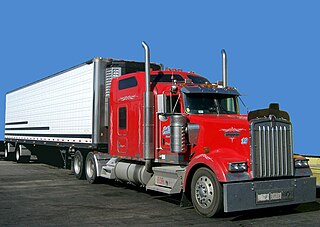
A commercial driver's license (CDL) is a driver's license required in the United States to operate large and heavy vehicles or a vehicle of any size that transports hazardous materials or more than 15 passengers.

A truck driver is a person who earns a living as the driver of a truck, which is commonly defined as a large goods vehicle (LGV) or heavy goods vehicle (HGV).

A weigh station is a checkpoint along a highway to inspect vehicular weights and safety compliance criteria. Usually, trucks and commercial vehicles are subject to the inspection.

Freight companies are companies that specialize in the moving of freight, or cargo, from one place to another. These companies are divided into several variant sections. For example, international freight forwarders ship goods internationally from country to country, and domestic freight forwarders, ship goods within a single country.
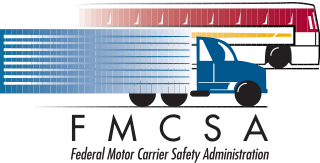
The Federal Motor Carrier Safety Administration (FMCSA) is an agency in the United States Department of Transportation that regulates the trucking industry in the United States. The primary mission of the FMCSA is to reduce crashes, injuries and fatalities involving large trucks and buses.
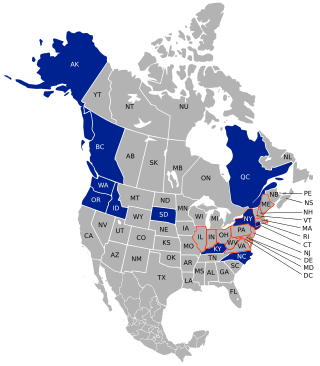
NORPASS is a not-for-profit organization formed from a partnership between state agencies and the North American trucking industry. The program issues electronic transponders and provides a weigh station bypassing service for truckers in Alaska, British Columbia, Connecticut, Idaho, Kentucky, North Carolina, New York, Oregon, Quebec, South Dakota, and Washington. Two service centres, operated by the Kentucky Transportation Center at the University of Kentucky and the Washington State Department of Transportation, coordinate efforts of NORPASS.

Hours of Service (HOS) regulations are issued by the Federal Motor Carrier Safety Administration (FMCSA) and govern the working hours of anyone operating a commercial motor vehicle (CMV) in the United States. These regulations apply to truck drivers, commercial and intercity bus drivers, and school bus drivers who operate CMVs. These rules limit the number of daily and weekly hours spent driving and working, and regulate the minimum amount of time drivers must spend resting between driving shifts. For intrastate commerce, the respective state's regulations apply.

The Federal Bridge Gross Weight Formula, also known as Bridge Formula B or the Federal Bridge Formula, is a mathematical formula in use in the United States by truck drivers and Department of Transportation (DOT) officials to determine the appropriate maximum gross weight for a commercial motor vehicle (CMV) based on axle number and spacing. The formula is part of federal weight and size regulations regarding interstate commercial traffic. The formula is necessary to prevent heavy vehicles from damaging roads and bridges. CMVs are most often tractor-trailers or buses, but the formula is of most interest to truck drivers due to the heavy loads their vehicles often carry.
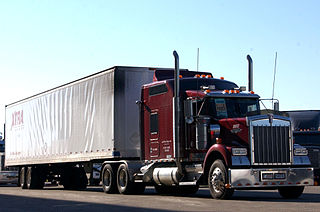
The trucking industry serves the American economy by transporting large quantities of raw materials, works in process, and finished goods over land—typically from manufacturing plants to retail distribution centers. Trucks are also used in the construction industry, two of which require dump trucks and portable concrete mixers to move the large amounts of rocks, dirt, concrete, and other building materials used in construction. Trucks in America are responsible for the majority of freight movement over land and are tools in the manufacturing, transportation, and warehousing industries.
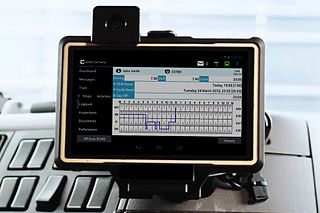
An electronic on-board recorder (EOBR) is an electronic device attached to a commercial motor vehicle, which is used to record the amount of time a vehicle is being driven. This is similar to the tachograph, and is the American equivalent of the digital tachograph used in Europe. Trucks in the European Union are required to have digital tachographs installed, and are securely monitored by government agencies. However, in Europe, the new digital tachograph which is considered secure, can be tricked with a round magnet placed by drivers over the connection to the transmission box. Usually they tie a rope to that magnet, and with a simple pull, the magnet will disengage and will show that the driver started moving about half an hour ago . The majority of carriers and drivers in the United States currently use paper-based log books. On January 31, 2011, the U.S. Federal Motor Carrier Safety Administration (FMCSA) proposed a rule requiring Electronic On-Board Recorders for interstate commercial truck and bus companies. The proposed rule covers interstate carriers that currently use log books to record driver's hours of service. The proposal would affect more than 500,000 carriers in the United States and carriers that currently use time cards would be exempt.
The motor carrier safety rating is an evaluation given to an interstate commercial motor carrier by the Federal Motor Carrier Safety Administration (FMCSA).
A specialized set of jargon describe the tools, equipment, and employment sectors used in the trucking industry in the United States. Some terms may be used within other English-speaking countries, or within the freight industry in general. For example, shore power is a term borrowed from shipping terminology, in which electrical power is transferred from shore to ship, instead of the ship relying upon idling its engines. Drawing power from land lines is more efficient than engine idling and eliminates localized air pollution. Another borrowed term is "landing gear", which refers to the legs which support the front end of a semi-trailer when it is not connected to a semi-truck. Some nicknames are obvious wordplay, such as "portable parking lot", in reference to a truck that carries automobiles.
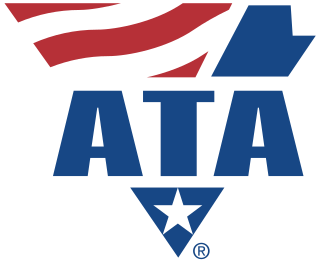
The American Trucking Associations (ATA), founded in 1933, is the largest national trade association for the trucking industry. ATA represents more than 37,000 members covering every type of motor carrier in the United States through a federation of other trucking groups, industry-related conferences, and its 50 affiliated state trucking associations. Former Governor of Kansas Bill Graves was replaced by Chris Spear as the ATA's president and CEO in July 2016.
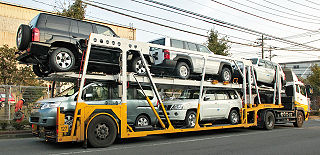
An auto transport broker is a type of cargo broker that specializes in the shipping and transportation of vehicles. Most vehicles shipped in the U.S. are cars and trucks, but many brokers handle boats, RVs, motorcycles and other types of vehicles as well. Auto transport is classified as "specialized freight trucking" under NAICS code 484230.

People who are driving as part of their work duties are an important road user category. First, workers themselves are at risk of road traffic injury. Contributing factors include fatigue and long work hours, delivery pressures, distractions from mobile phones and other devices, lack of training to operate the assigned vehicle, vehicle defects, use of prescription and non-prescription medications, medical conditions, and poor journey planning. Death, disability, or injury of a family wage earner due to road traffic injury, in addition to causing emotional pain and suffering, creates economic hardship for the injured worker and family members that may persist well beyond the event itself.

Public Law 113-45 is an American Act of Congress which requires that the Federal Motor Carrier Safety Administration go through the standard rulemaking proceeding, allowing comment from the public and the trucking industry, before it sets any requirements for truck drivers related to sleep apnea. It was introduced in the United States House of Representatives during the 113th United States Congress and was signed into law by President Barack Obama in October 2013.
Drivewyze is an intelligent transportation system (ITS) service that provides bypasses to commercial vehicles as they approach participating state highway weigh stations. The participating vehicles' safety record, credentials and weight are verified automatically, and if they comply with that state's screening rules for automated bypass, the vehicles are authorized to bypass these facilities rather than pull in for manual inspection. This results in time and fuel savings for the truck and less vehicle congestion at the weigh station.
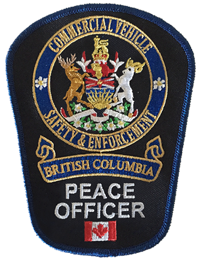
British Columbia Commercial Vehicle Safety & Enforcement (BCCVSE) is a provincial law enforcement agency that is responsible for the compliance and enforcement of the commercial transport sector, protection of the environment and transportation infrastructure of British Columbia, increasing road safety and protecting the motoring public.
An Electronic Logging Device is a piece of electronic hardware attached to a commercial motor vehicle engine to record driving hours. The driving hours of commercial drivers are typically regulated by a set of rules known as the hours of service (HOS) in the United States and as drivers' working hours in Europe. The Commercial Vehicle Driver Hours of Service Regulations vary in Canada and the United States.
The Commercial Vehicle Safety Alliance (CVSA) is a non-profit association of local, state, provincial, territorial and federal commercial motor vehicle safety officials and industry representatives. CVSA focuses on improving driver and vehicle safety by providing guidance to organizations that enforce commercial motor vehicle inspections and certify inspectors, and reports over 4,000 members in the United States, Canada and Mexico.
References
- ↑ "Our Story". PrePass. Retrieved 2018-10-16.
- ↑ "PrePass Benefits Carriers, States". Bulk Transporter. 1998-07-01. Retrieved 2018-10-16.
- ↑ "PrePass". OOIDA . Retrieved 2018-10-16.
- ↑ "SafeStat Monitoring". National Association of Small Trucking Companies (NASTC). Retrieved 18 October 2018.
- ↑ "The Inspection Selection System". FMCSA. Retrieved 18 October 2018.
- ↑ "Improving Motor Carrier Safety Measurement (2017)". National Academies of Sciences . Retrieved 18 October 2018.
- ↑ Huff, Aaron (2018-04-11). "Drivers taking advantage of PrePass partnership with NorPass". Overdrive. Retrieved 2018-10-16.
- ↑ Kilcarr, Sean (2017-10-22). "PrePass unveils ELD app for phones, tablets". FleetOwner. Retrieved 2018-10-16.